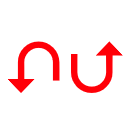In data that should actually be used to calibrate an instrument, researchers accidentally discover a previously unknown asteroid.
Baltimore/Garching - The "James Webb" space telescope of the space organizations Nasa, Esa and CSA is actually primarily intended to look deep into the universe.
It looks further and further back into the past and finds the oldest stars and galaxies.
Now, however, the space telescope is drawing attention to itself with a completely different and completely unplanned find, as
reported
by fr.de.
"We discovered - completely unexpectedly - a small asteroid in the publicly available MIRI calibration images," explains astronomer Thomas Müller from the Max Planck Institute for Extraterrestrial Physics in Garching.
MIRI (Mid-Infrared Instrument) is one of the astronomical instruments of the "Webb" telescope, with it the universe can be observed in the mid-infrared light spectrum.
"Our work indicates that many new objects can be discovered with this instrument," Müller continues.
James Webb telescope accidentally discovers an asteroid
The images in which the asteroid was discovered actually targeted main-belt asteroid 1998 BC1, which was discovered back in 1998.
The observations were made to test some MIRI filters and to calibrate the instrument - however, the calibration team subsequently decided that the tests had failed for technical reasons.
When examining the data, Müller's team came across the small asteroid.
It is about 100 to 200 meters long, making it very likely the smallest object observed by the James Webb telescope to date.
The asteroid, about the size of the Colosseum in Rome, is located in the asteroid belt between the planets Mars and Jupiter.
Further observations are needed to find out more about the celestial body.
Space telescope finds asteroids in 'failed' images
"Our results show that even 'failed' 'Webb' observations can be scientifically useful if you have the right attitude and a bit of luck," says Müller.
"Our discovery is in the main asteroid belt, but Webb's incredible sensitivity made it possible to see this roughly 100-meter-wide object more than 100 million kilometers away."
+
A research team finds a new asteroid in data from the James Webb Space Telescope.
(icon picture)
© N. Bartmann (ESA/Webb), ESO/M.
Kornmesser and S. Brunier, N. Risinger
The newly discovered asteroid has not yet been confirmed.
If confirmed, it should have important implications for our understanding of how the solar system formed and evolved.
In contrast to large asteroids, small asteroids have not been studied in detail because they are difficult to observe.
In the future, however, the "James Webb" telescope could be used for this.
These surprises are hidden in the images from the James Webb telescope
These surprises are hidden in the images from the James Webb telescope
NASA/ESA space telescope to discover more asteroids
The new space telescope is likely to continue to contribute to the discovery of new asteroids in the future.
The team suspects that even brief MIRI observations near the solar system plane will always include a few asteroids, most of which are likely to be unknown objects, according to a statement from the US space agency Nasa.
"This is a fantastic result that underscores MIRI's ability to accidentally discover asteroids of previously undetectable sizes in the main belt," said Bryan Holler of the Space Telescope Science Institute.
"Repeat observations are planned and we expect new asteroids to appear in these images." (tab)













